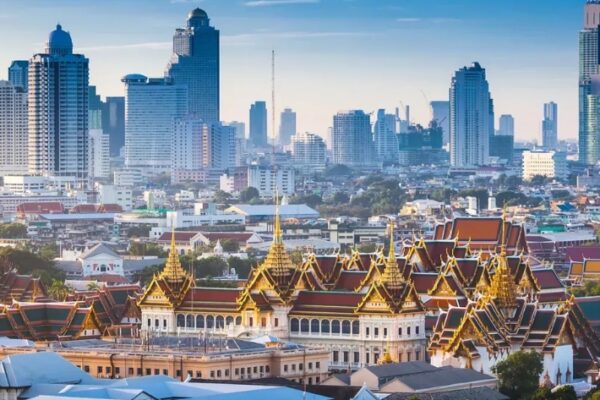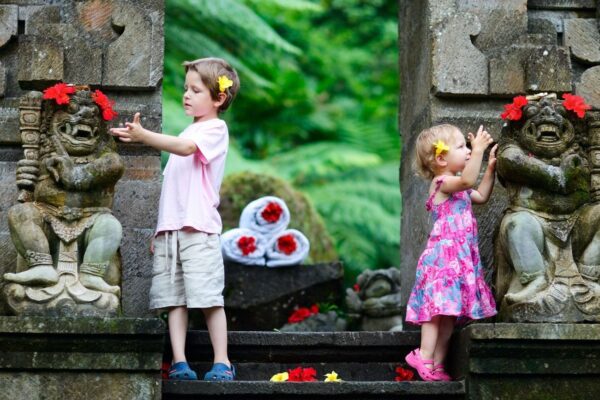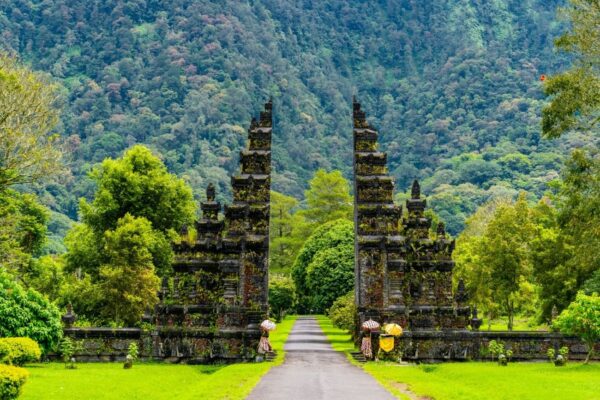25 Free Things to Do in Bali That Don’t Feel Budget at All
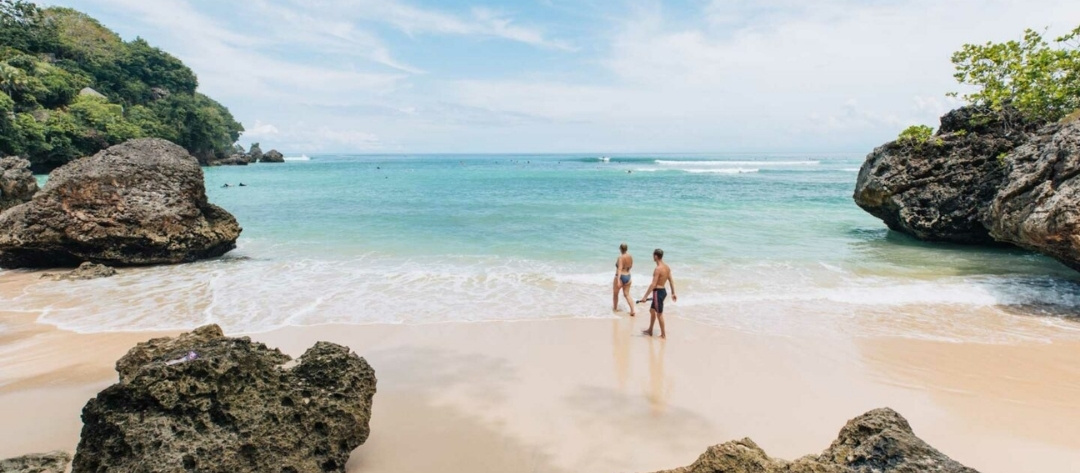
Bali isn’t only for luxury seekers; it’s also a paradise for those who love experiences without high costs. This guide to free things to do in Bali is designed for budget travelers, couples, families, and digital nomads who want authentic adventures without overspending. Discover temples, beaches, and cultural gems that offer unforgettable memories without a cost. Read on to discover how you can enjoy Bali at its best, while keeping your travel budget in check.
Nature & Outdoor Walks: Scenic Free Things to Do in Bali
Immersing oneself in the wild rhythms of Bali costs nothing but time and presence. For travelers yearning for authenticity, free things to do in Bali often begin with nature—the kind that reshapes your breath and slows your thoughts.
Campuhan Ridge Walk (Ubud)
Only minutes from central Ubud, this verdant path cuts through the spiritual and scenic. Beginning near Pura Gunung Lebah, the Campuhan Ridge unfurls into a panoramic trail where grasslands meet jungle canopies.
The total stretch spans approximately 6 kilometers, but a tranquil 2-kilometer segment delivers what matters most: stillness, serenity, and sweeping vistas. End your stroll in Bangkiang Sidem village, where the simplicity of Balinese countryside life gently humbles modern sensibilities. Arrive with the sunrise; leave before the foot traffic dims the experience.
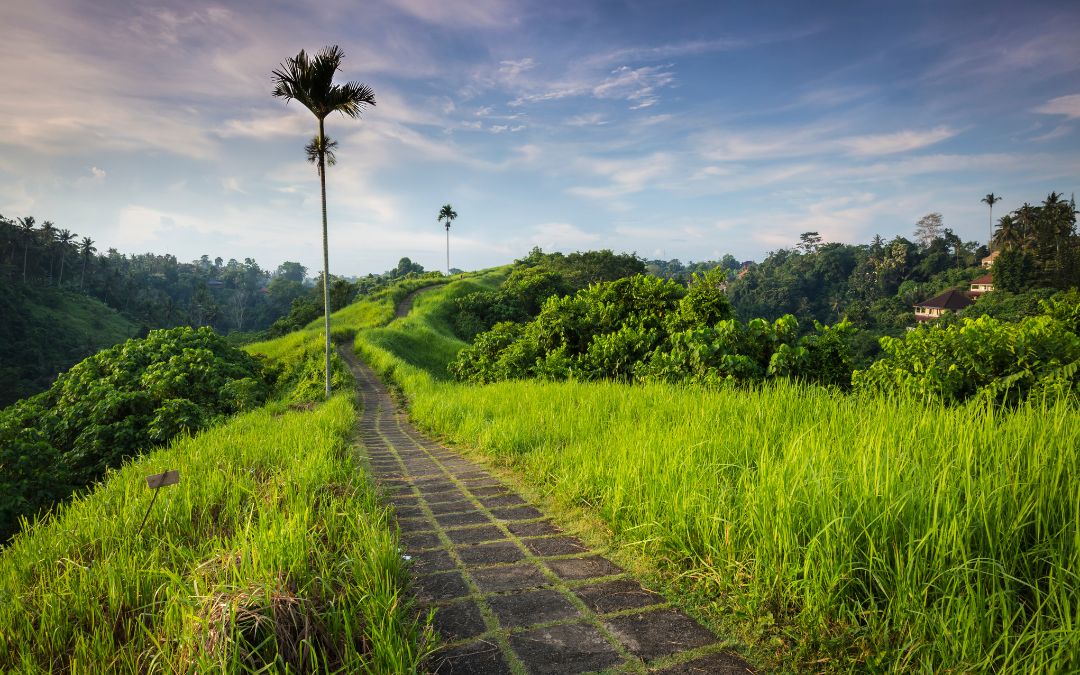
The Campuhan Ridge Walk glows at sunrise in Ubud.
Tegalalang Rice Terraces (Ubud)
Recognized by UNESCO for its subak irrigation heritage, Tegalalang commands reverence. While the leading site now charges around 50,000 IDR (~$3 USD), several equally enchanting alternatives remain accessible without charge.
Kajeng and Penestanan Rice Walks wind through open paddies kissed by golden light. Each terrace, layered with precision and patience, reminds visitors that nature’s architecture has soul. Avoid the crowds by arriving at dawn when dew still clings to each blade.
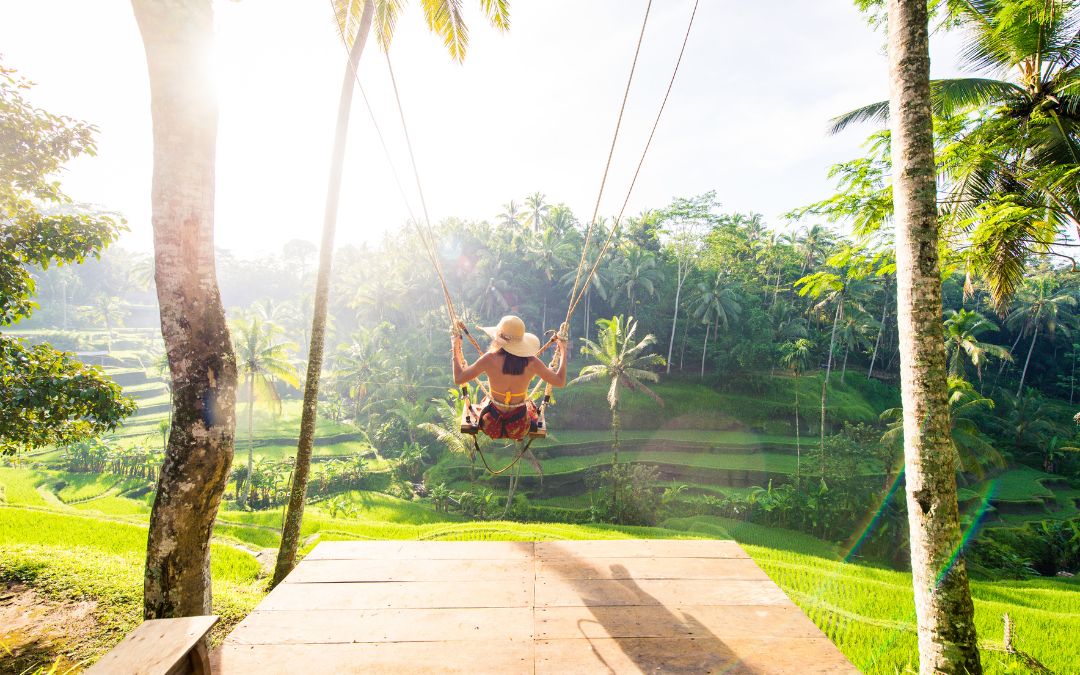
Tegalalang Rice Terraces shimmer with every morning mist.
Munduk Waterfalls Trek
In North Bali’s highlands, Munduk whispers a different language—cooler air, richer greens, and the ever-present lull of falling water. The region is home to four mesmerizing cascades: Red Coral, Melanting, Labuhan Kebo, and Golden Valley. Trekking between them is a half-day immersion into floral tunnels and terraced hillsides.
While some paths may request small contributions ($1–$2 USD), the enchantment flowing through this area is profoundly invaluable. The absence of ticket booths along lesser-known trails suggests a rawer, more honest encounter with nature.
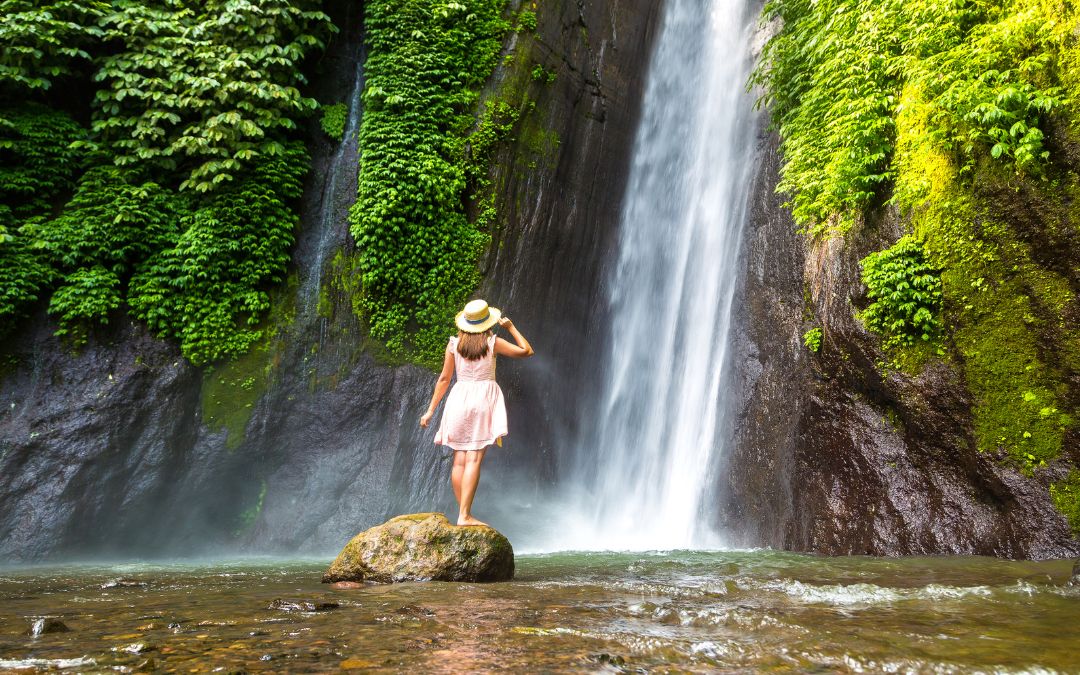
Misty trails lead hikers to Munduk’s cascading waterfalls.
Twin Lakes Viewpoint (Buyan & Tamblingan)
Near Munduk Village, steep roads climb toward a celestial overlook. The viewpoint gazes upon Lakes Buyan and Tamblingan—two sapphire mirrors cradled by forested hills. Though no entrance fee is required, travelers may opt to visit Wanagiri Hidden Hills nearby for photos at an additional 50,000 IDR.
Still, the lakes themselves—reflective and remote—feel untouched. Fruit markets scatter along the roadside, selling fresh harvests from what locals affectionately call the Bread Basket of Bali.
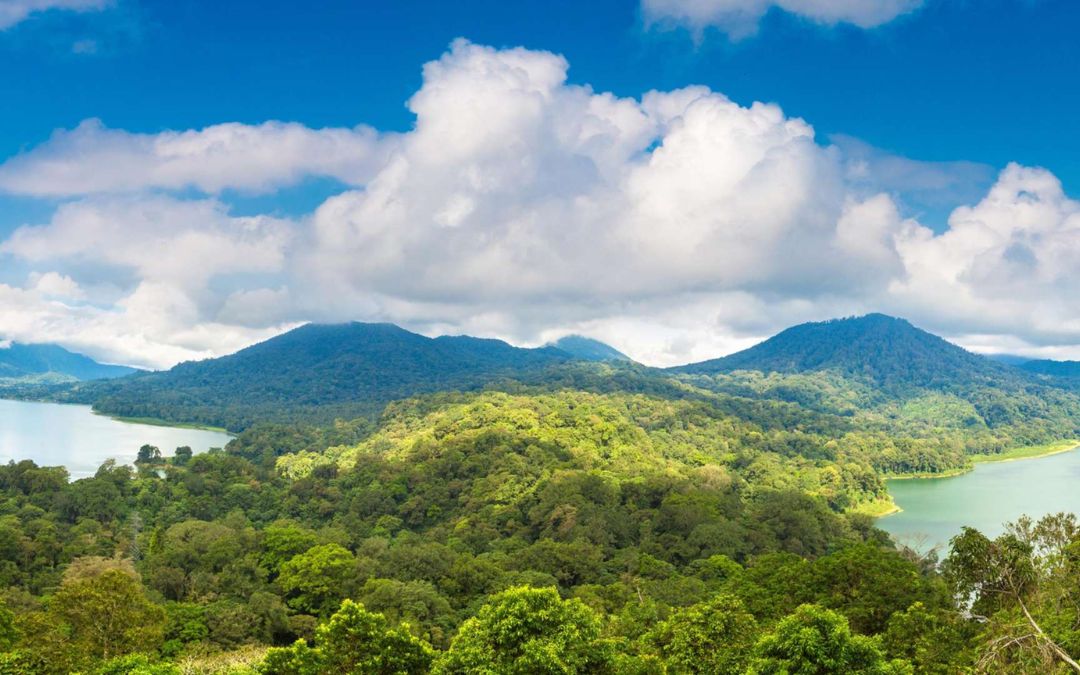
Twin Lakes Viewpoint reveals Buyan and Tamblingan’s calm charm.
Sunrise Over Mount Batur (Kintamani)
Though ascending Batur’s summit necessitates a guide and associated costs, watching its silhouette glow in morning light does not. In Kintamani, charming cafés perch on the crater’s edge, offering postcard-perfect views without expectation. One recommended activity involves cycling downhill from this elevation, coasting past traditional villages as the volcano recedes behind rice fields and rolling clouds.
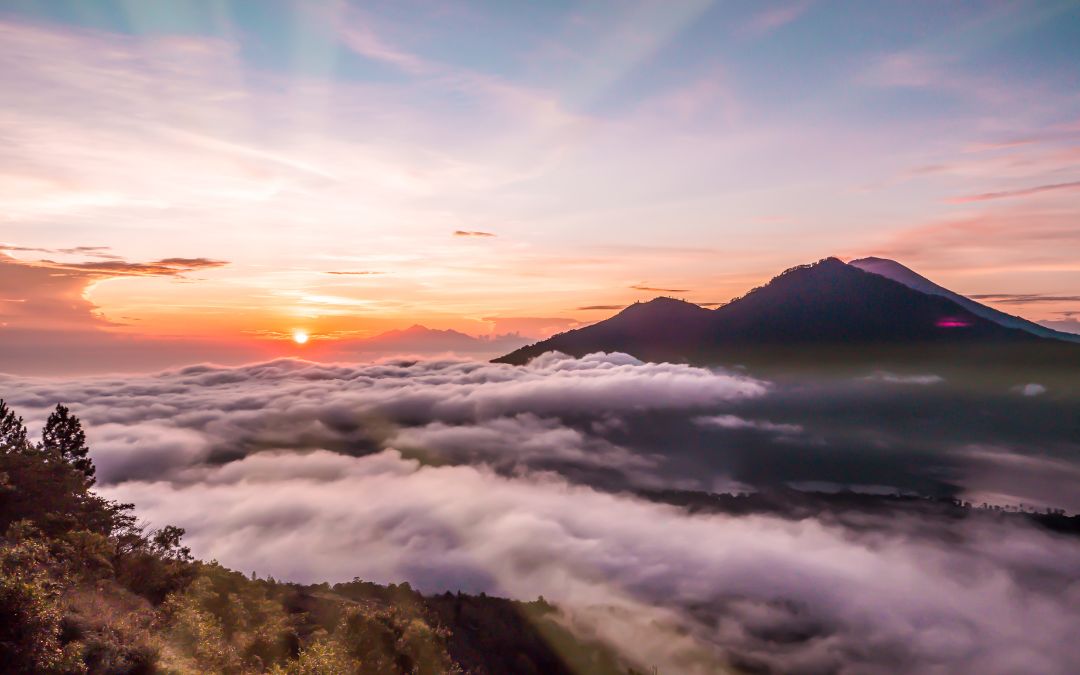
Dawn paints Mount Batur in golden fire above Kintamani.
Hidden Beaches Hike (Uluwatu)
Between Padang Padang and Bingin lies a coastline of dramatic cliffs and secret coves. To reach them demands effort—stairs, stones, and sturdy resolve. But each descent pays off: Green Bowl Beach unveils sea caves shaped by centuries.
Nyang Nyang’s untouched shore stretches long and wide, a canvas for footprints and seafoam. Bingin offers reef breaks for surfers and chilled rhythm for dreamers. All this, freely gifted by the island—if you’re willing to walk.
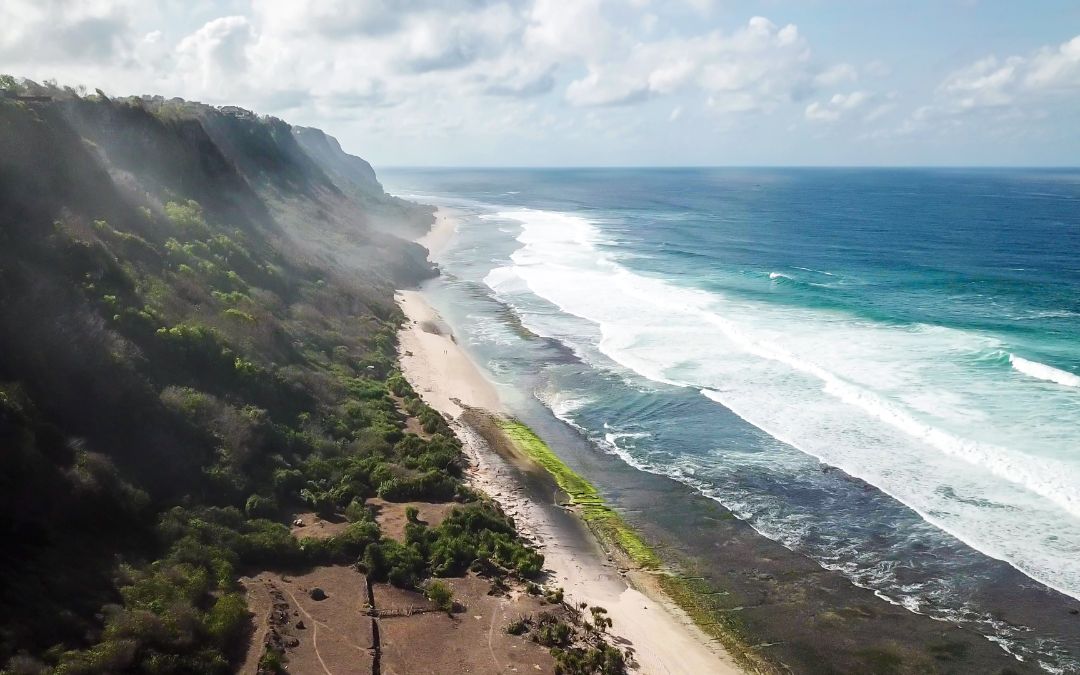
Hidden cliffs guide adventurers to Uluwatu’s secret beaches.
Pro tips for a free-spirited trekker:
- Avoid peak heat and crowd congestion by setting off early. Especially at places like Campuhan or the Tegalalang terraces, timing determines tranquility.
- Equip yourself with durable footwear; uneven trails are commonplace, particularly in Uluwatu and Munduk.
- Carry water and kindness. Though you walk without paying, you traverse paths shaped by generations of care.
Beaches & Coastal Gems: Where the Shoreline Gives Generously
Along Bali’s vivid shoreline, every tide, breeze, and horizon comes without a price tag. For travelers committed to authenticity over extravagance, these coastal escapes become more than destinations—they become memory-makers. When exploring free things to do in Bali, the beaches offer a profound sense of freedom, each one distinct in texture, tempo, and terrain.
Padang Padang Beach (Bukit Peninsula)
Golden sands shimmer beneath rugged cliffs, while turquoise waves roll with rhythmic persistence. Padang Padang Beach—tucked under a limestone overhang—is not just scenic; it’s legendary. Surfers revere its breaks. Photographers chase the glow of evening light.
And for the observant, wild Balinese monkeys provide unscripted entertainment in the surrounding trees. Reaching the beach involves descending through a narrow rock gap—a natural gateway to one of Uluwatu’s coastal treasures.
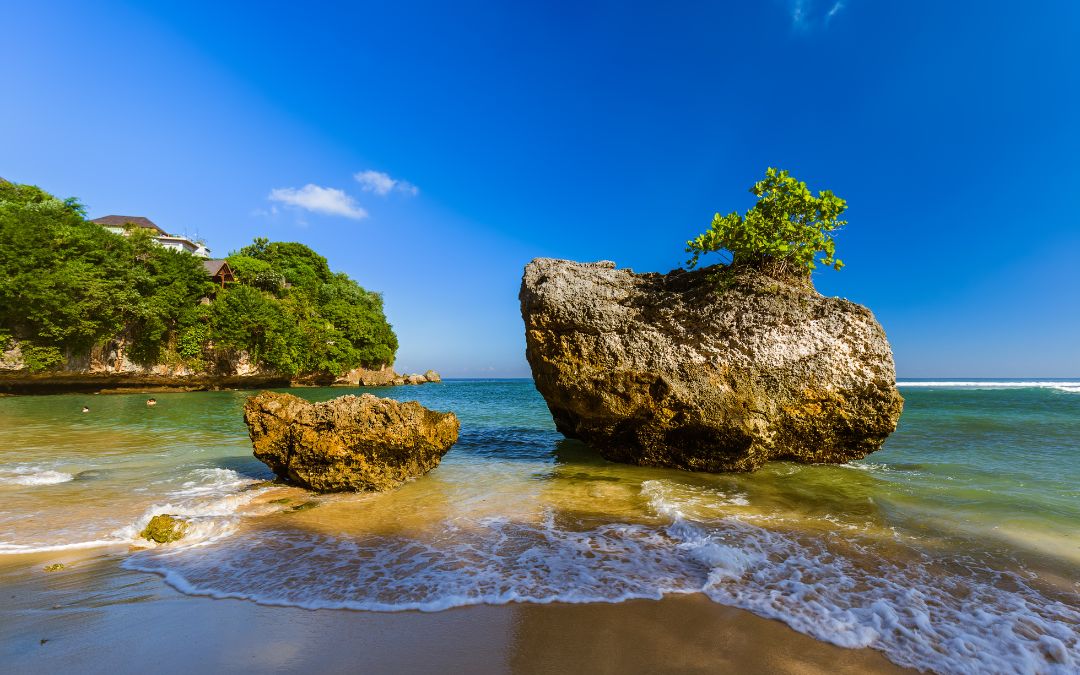
Waves crash dramatically at Padang Padang Beach.
Sanur Beach Promenade
Sanur whispers peace where other beaches roar. This east-facing stretch offers a paved promenade ideal for early jogs, relaxed bike rides, or hand-in-hand strolls. Beyond the shoreline, calm lagoons host paddleboarders and casual swimmers.
Visitors often linger near the Sindhu Night Market, where food stalls pulse with local flavor after dusk. Though entirely walkable, Sanur’s quiet rhythm makes it ideal for families, slow travelers, and anyone craving contemplative ocean air.
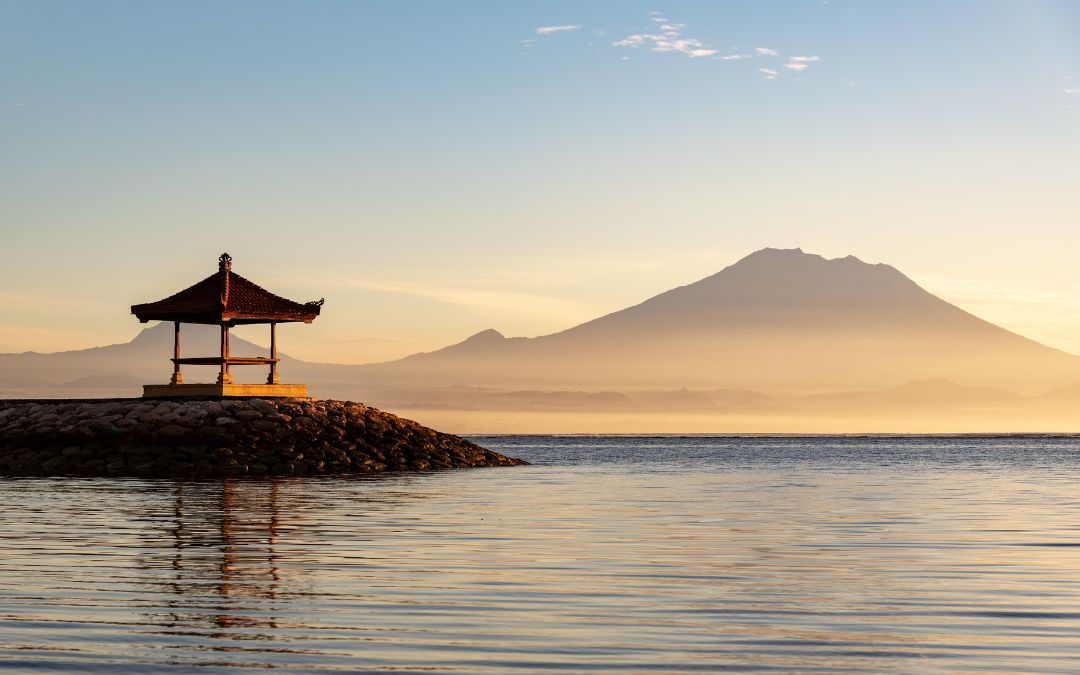
Gentle waves line the peaceful Sanur Beach Promenade at sunrise.
Bingin Beach
Bingin rewards those who venture downward—literally. Dozens of steep steps separate the clifftop from this intimate cove, but what awaits is worth every effort. During low tide, the terrain transforms, revealing tidal rocks and coral patches that make sunbathing trickier but marine watching easier.
High tide, however, smooths the experience into something sublime. Known for its strong swell and soulful ambiance, Bingin remains under-touristed—ideal for introverts, surfers, and sunset chasers seeking solitude.
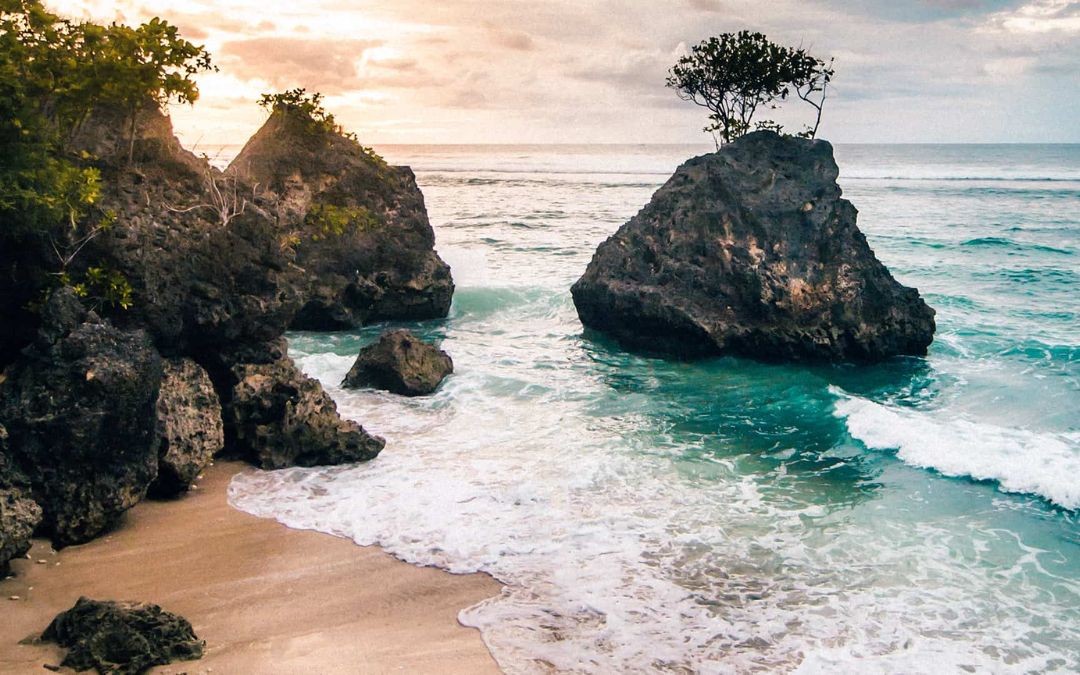
Bingin Beach welcomes surfers with steady barrels.
Nusa Dua Public Beach
In the southern embrace of Bali, Nusa Dua balances polish with accessibility. While much of the area caters to five-star elegance, its public beach remains open and generous. The sand is soft, the entry is flat, and the waters are often still, making it a haven for casual dips.
Adjacent to the Tanjung Benoa Peninsula, a watersports mecca unfolds with jet skis, banana boats, and parasailing. Yet, no activity is compulsory; listening to waves and watching locals practice ceremonies on the sand is wholly enough.
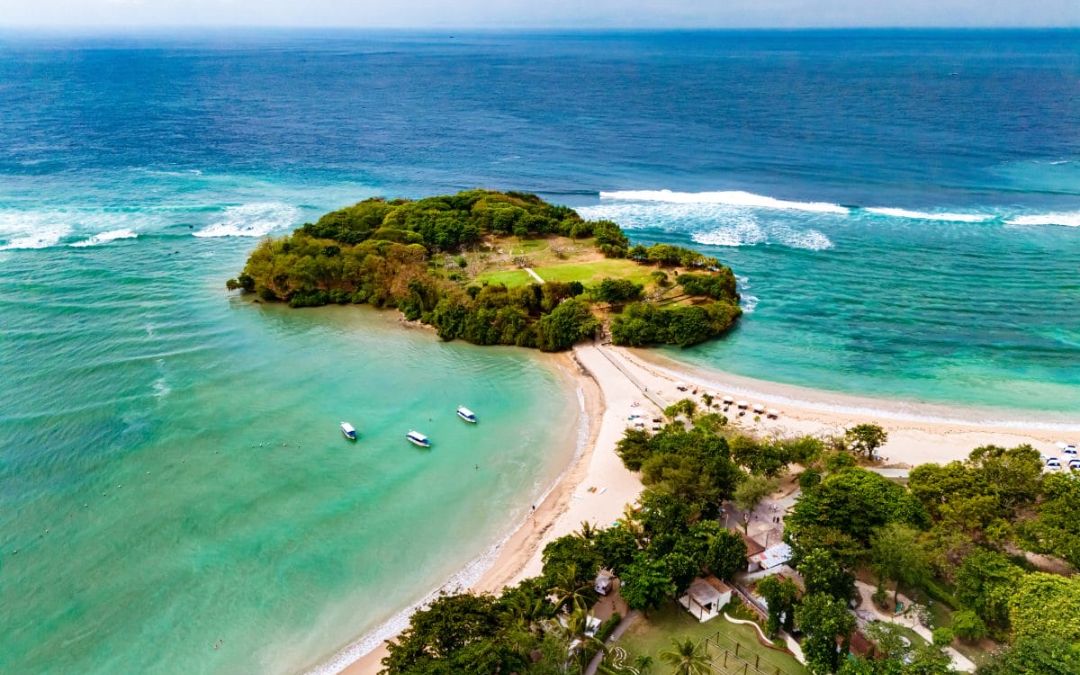
Nusa Dua Public Beach offers soft sands and calm tides.
Melasti Beach Clifftop Viewpoint
Gracefully framed by towering cliffs, Melasti Beach presents drama in every direction. Unlike many Uluwatu beaches that demand arduous treks, Melasti welcomes vehicles nearly to the shoreline.
Its viewpoint from above offers cinematic vistas, while below, beach clubs and humble warungs co-exist peacefully. Each evening, the beach becomes a stage for the Balinese Kecak dance—visibly raw, fiercely moving. Attending this seaside performance allows cultural immersion without the Uluwatu Temple’s notorious crowds.
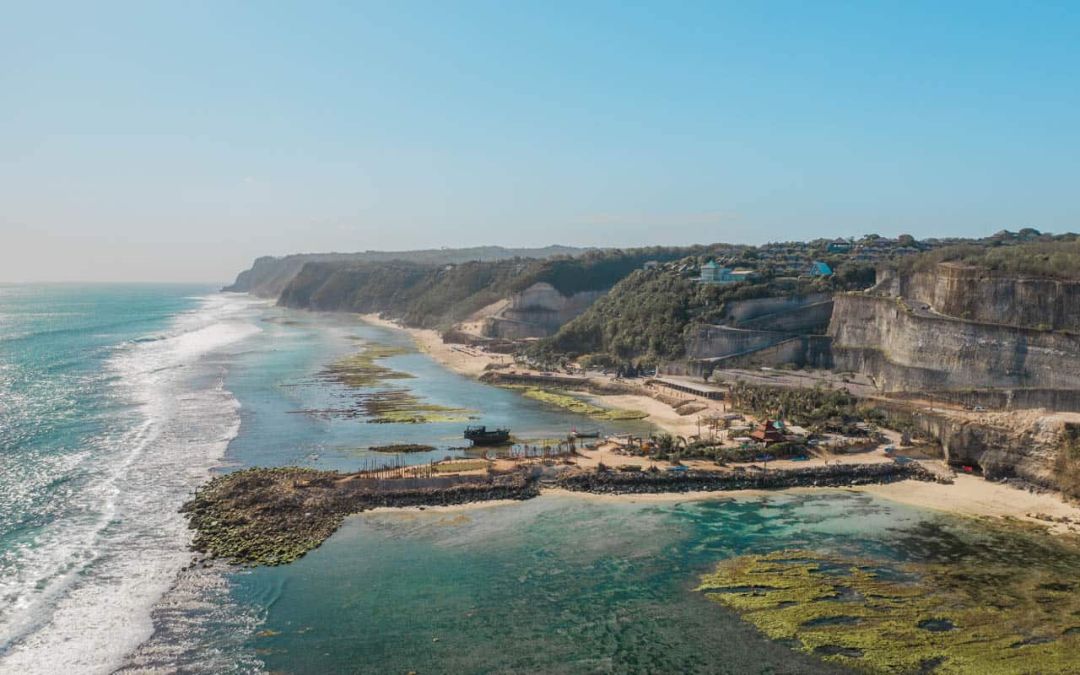
Melasti’s clifftop lookout frames turquoise perfection.
Echo Beach (Canggu)
Bohemian energy collides with beach-town cool at Echo Beach. Here, the rhythm is both auditory and visual—waves crashing, music playing, people watching. More than just a surf haven, Echo Beach pulses with personality.
Sunset seekers gather on steps beside La Brisa, sharing skies painted in apricot and indigo. Further down, Sand Bar erupts after dark into a barefoot dance floor. Yet even amid this revelry, the beach itself—open, untamed, and always free—remains the star.
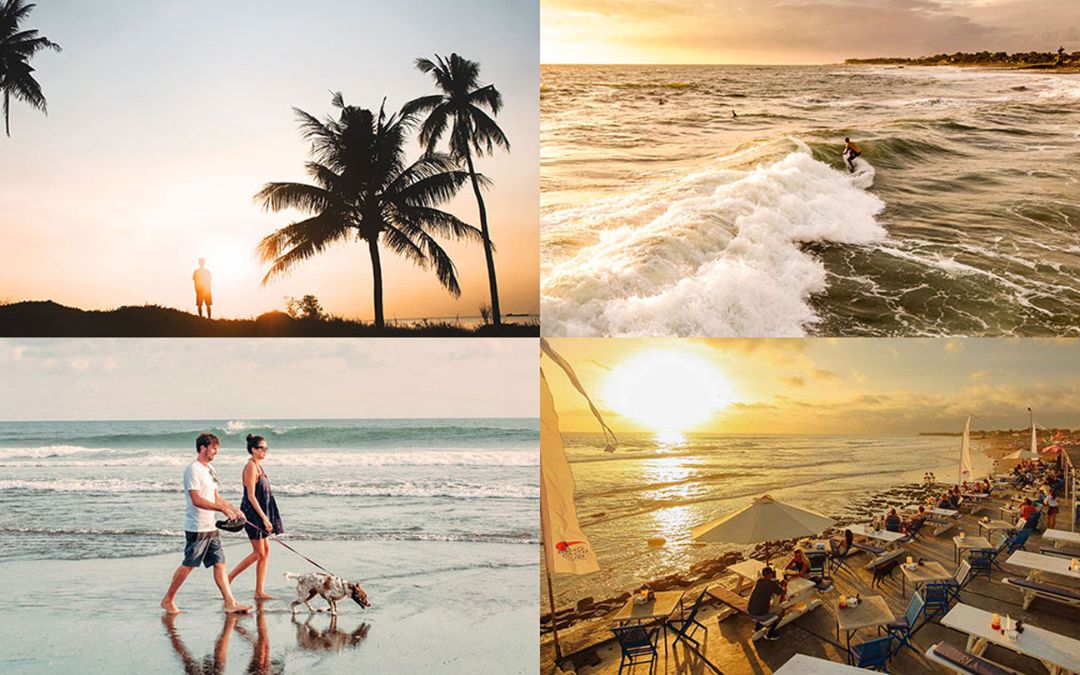
Echo Beach in Canggu hums with sunset energy.
Coastal travel tips:
- Although entrance to these beaches is free, small costs like parking (around $0.35 USD) may apply.
- Carry loose rupiah, wear supportive footwear for cliff access, and monitor tide charts—especially at Bingin or Padang Padang.
- Most importantly, rise early or linger late. Bali’s beaches reveal their quietest beauty when the world is still waking or already winding down.
>> See Tour: Bali to Gili Island Hopping Tour
Culture & Temples: Free Entry to the Sacred Soul of Bali
Beyond its beaches and ridges, Bali pulses with spirit—alive in prayers, ceremonies, and sculpted stone. For those searching beyond surface pleasures, the island’s spiritual layer reveals experiences that cost nothing, yet offer everything. When seeking free things to do in Bali, nothing resonates deeper than its timeless temples and communal rituals.
Pura Taman Saraswati (Ubud)
In the heart of Ubud, tucked behind the unassuming Lotus Café, stands one of Bali’s most photogenic sanctuaries. Pura Taman Saraswati—also called the Ubud Water Palace—invites visitors not with grandeur, but grace. Its stone walkway rises above a mirror-like lotus pond, where pink blooms float beside intricate carvings of Hindu gods.
Constructed in 1952, the temple honors Saraswati, goddess of wisdom, art, and eloquence. Entering the inner courtyard reveals detailed sandstone reliefs that feel meditative in their silence. On select evenings, traditional Balinese dance performances unfold on the water stage, softly lit and emotionally charged.
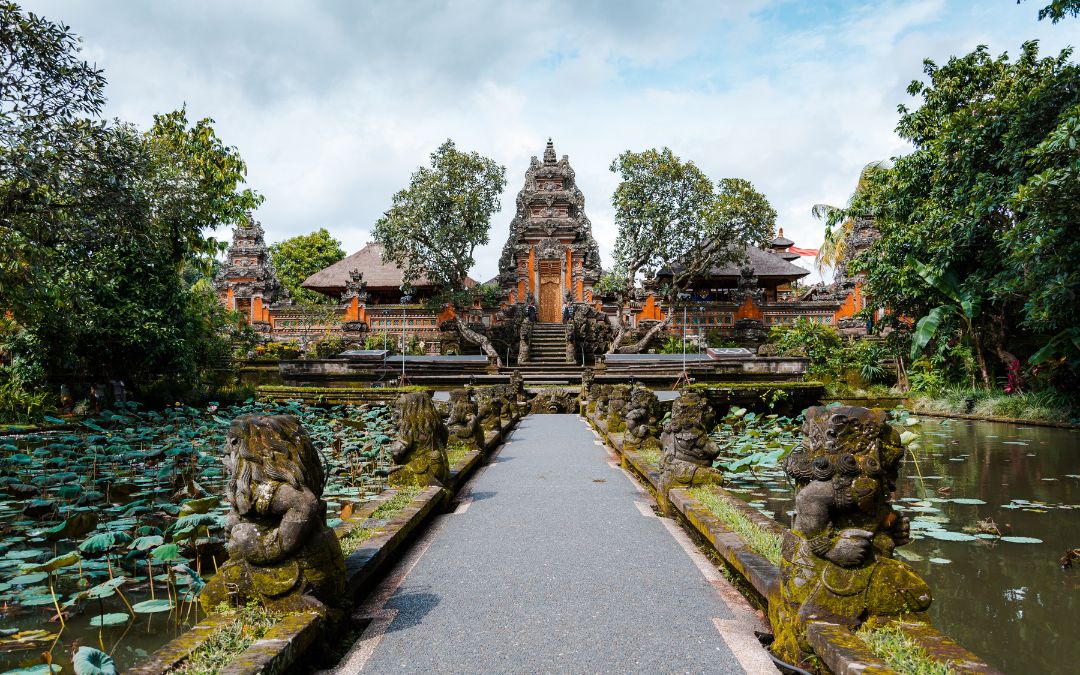
Pura Taman Saraswati sparkles with lotus-filled ponds.
Village Ceremonies
Chance sometimes offers the most profound moments. In Bali, wandering through a village at the right time may unveil an odalan—a temple anniversary, celebrated twice annually according to the 210-day Pawukon calendar. These ceremonies, filled with incense, gamelan music, and ceremonial attire, rarely charge spectators.
Instead, you are welcomed—often with a warm smile or even an invitation. Weddings, cremations, and community rites become immersive cultural windows, especially for guests staying in family-run guesthouses.
During Galungan and Kuningan, elaborately curved penjors line the streets, creating archways of bamboo, coconut leaves, and devotion. On Nyepi’s eve, wild Ogoh-Ogoh parades light up the night before Bali descends into sacred silence.
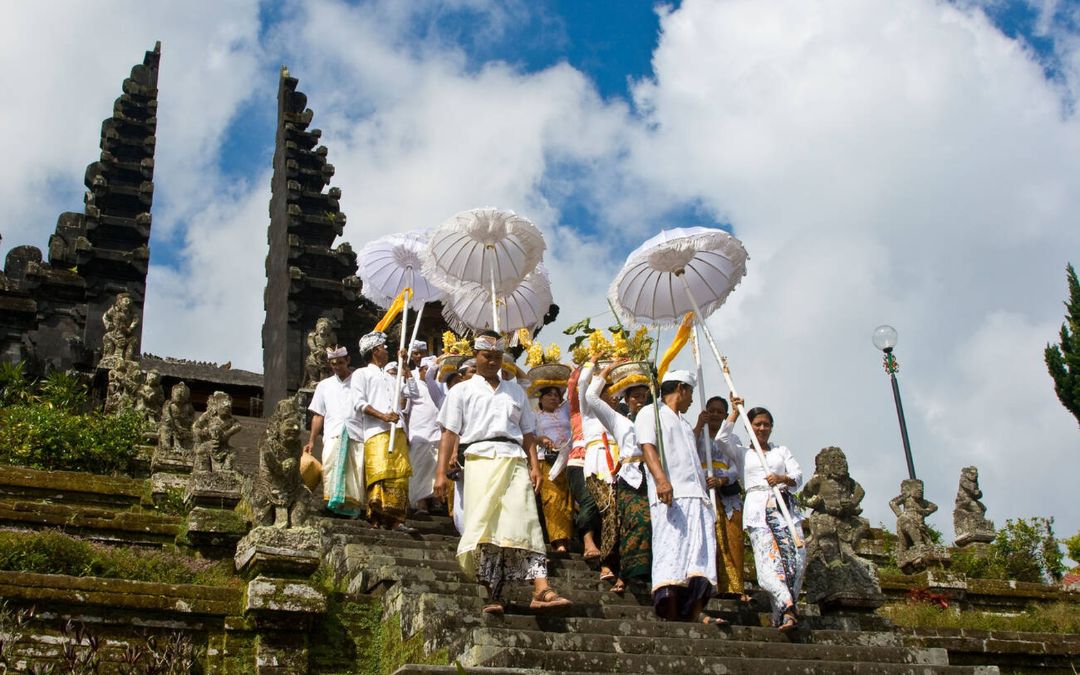
Odalan ceremonies fill Bali’s temples with music, color, and sacred dance.
Ubud Palace (Puri Saren Agung)
At the intersection of tradition and tourism lies the Ubud Palace—a relic of royal architecture enveloped in moss and mythology. Although the inner quarters remain private, the outer courtyards are freely accessible and speak volumes.
Ornate gates, tiered shrines, and manicured gardens form a tableau of Balinese aesthetics. In the evenings, this cultural landmark transforms into a performing arts venue, showcasing Legong dances accompanied by hypnotic gamelan orchestras.
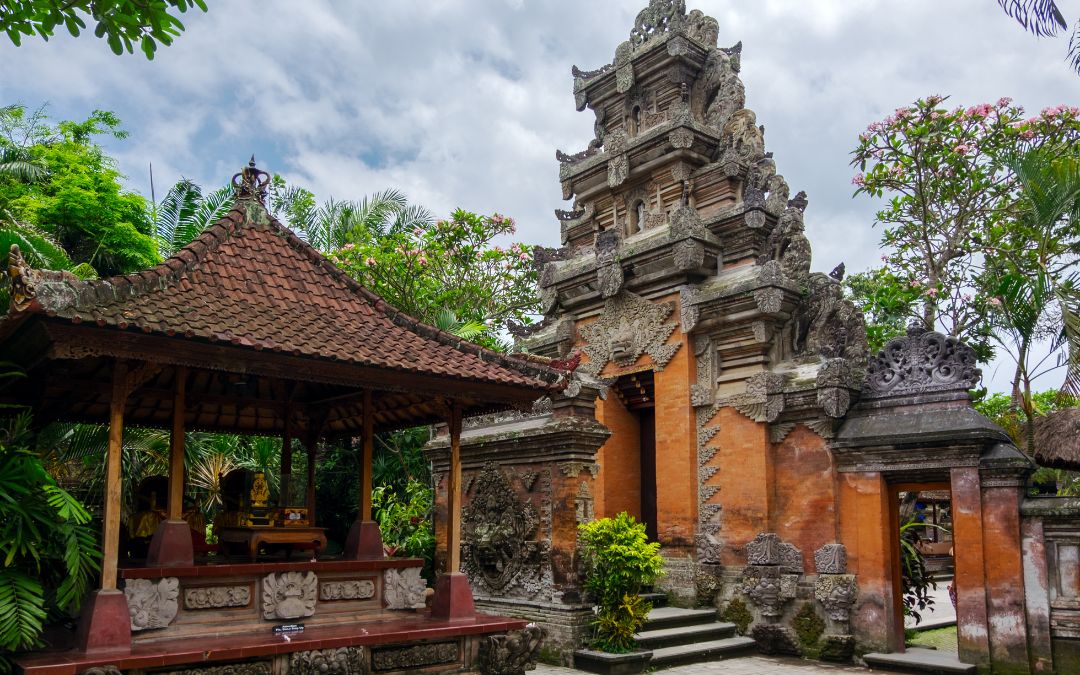
Royal walls of Ubud Palace guard stories of the past.
Subak Rice Field Walks
To walk a subak canal is to walk through time. This cooperative irrigation system, a UNESCO-recognized treasure, nourishes not just the land but the social and spiritual fabric of Bali. Small waterways snake through the rice paddies, each canal originating from sacred mountain temples and managed communally—a living testimony to harmony between nature, humans, and the divine.
While famous terraces like Tegalalang request an entrance fee, others do not. The Kajeng Rice Field Walk and Penestanan Rice Walk invite respectful wanderers to meander in silence, their only companion the rustle of stalks and the occasional temple bell in the distance.
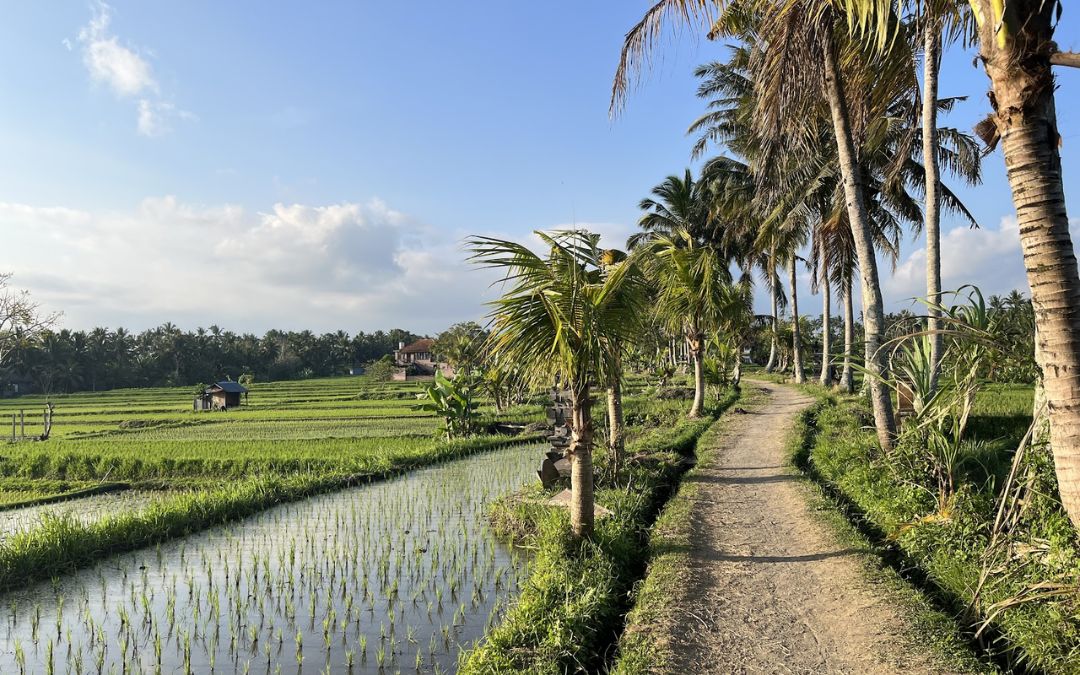
Subak Rice Field Walks celebrate harmony and hard work.
When visiting temples or joining local rituals in Bali, always keep in mind:
- Reverence is not optional—it is expected. When entering a temple or participating in a purification ritual (Melukat), modest clothing is non-negotiable.
- Sarongs, often provided at large temple entrances, must be tied around the waist.
- Should you join locals in a sacred rite, wear one with respect—not for the photo, but for the meaning.
>> Read More: Explore the Best Temples in Bali for Culture, Views, and Inner Peace
Markets & Town Life: Free Encounters with Everyday Bali
To wander Bali’s towns is to enter a world orchestrated in rhythm and color. In every market lane, temple square, and tiled corner, the island reveals itself—bold, fragrant, unhurried. These places ask for no admission, only attention.
Ubud Art Market: The Pulse of Handmade Beauty
Immortalized by Eat Pray Love and visited by travelers from every continent, the Ubud Art Market is less a place to shop than to absorb. Located in central Ubud, opposite the royal palace, it beckons with a mosaic of textures: embroidered bags, hand-carved masks, luminous batik, and polished silver. Even if you leave empty-handed, you gain something intangible—a glimpse of craftsmanship, heritage, and the intricate dialogue between tourism and tradition.
Be aware, however, that most stalls are operated by wholesalers. For seekers of deeper authenticity, the Mas Village Carving Center offers a more intimate view of wood artisans sculpting myth into form. A quieter alternative to the main market lies a few lanes away: the Anjuna Art Market, calmer, more candid, and ideal for the introspective flâneur.
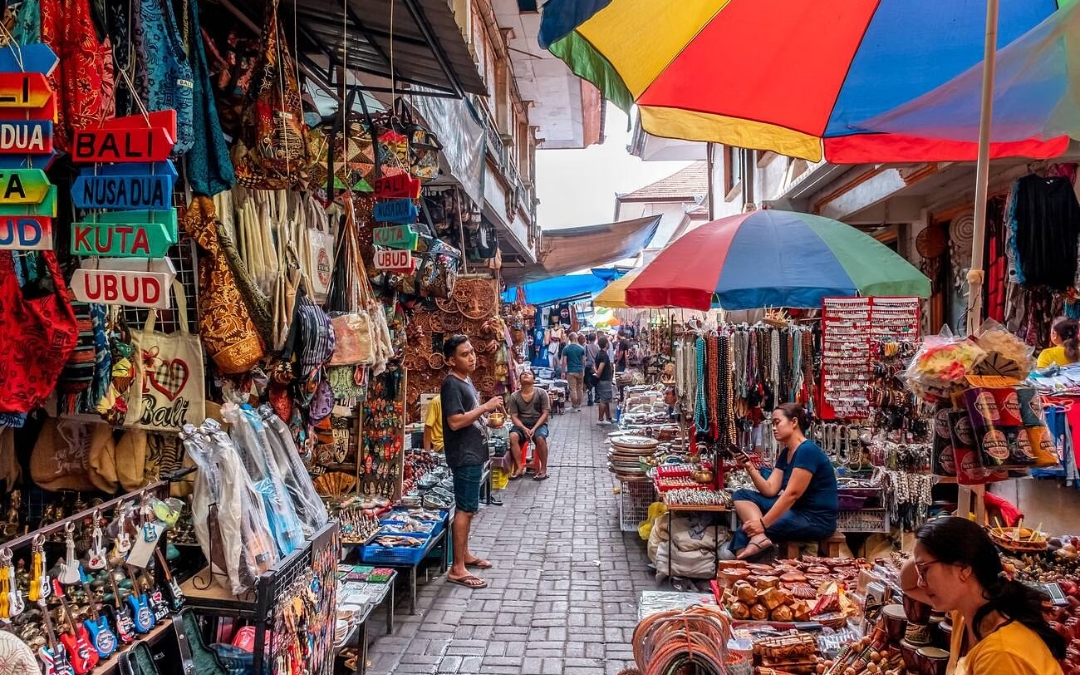
Ubud Art Market bursts with colors of handmade craft.
Canggu’s Alleyways: Surf Culture with Soul
Canggu doesn’t need a stage—it lives as one. Though not officially cited for its street art, the ambiance here is infused with creative rebellion. Murals appear without prelude, behind cafés or tucked into alley walls—sometimes abstract, sometimes confrontational.
Every visual feels spontaneous yet intentional. Combined with its brunch temples and slow-fashion shops, Canggu creates an immersive street-level gallery, all viewed at no cost but your curiosity.
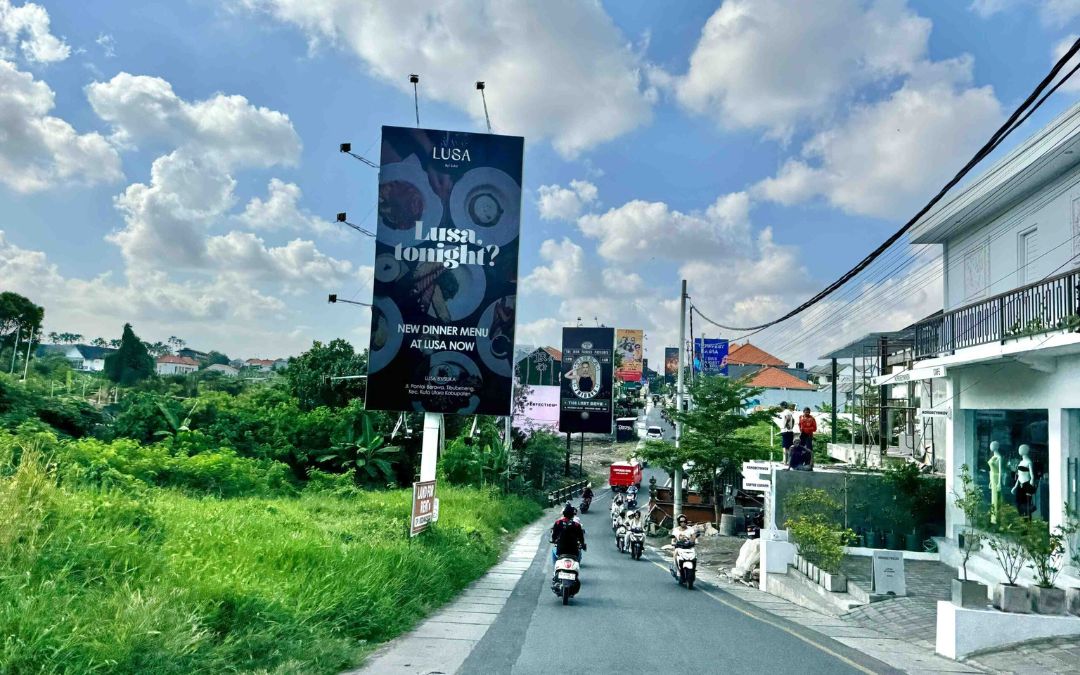
Canggu’s alleyways echo surf beats and street art.
Pasar Malam: A Symphony of Senses
Night falls differently over Bali’s pasar malam. As lanterns glow and grills hiss, these open-air markets awaken appetites—for flavor, yes, but also for culture. Wander past stalls brimming with banana fritters, jackfruit, incense, and fried tempeh. Watch locals laugh over satay skewers, bargain over handmade goods, or gently haggle for woven baskets. It’s free to browse, to inhale, to feel the tempo of the evening rise with the crowd.
Highly recommended are the Sindhu Night Market in Sanur, Gianyar Night Market, and the Kuta Night Market—each buzzing with local stories, each a universe of discovery that begins the moment you step inside.
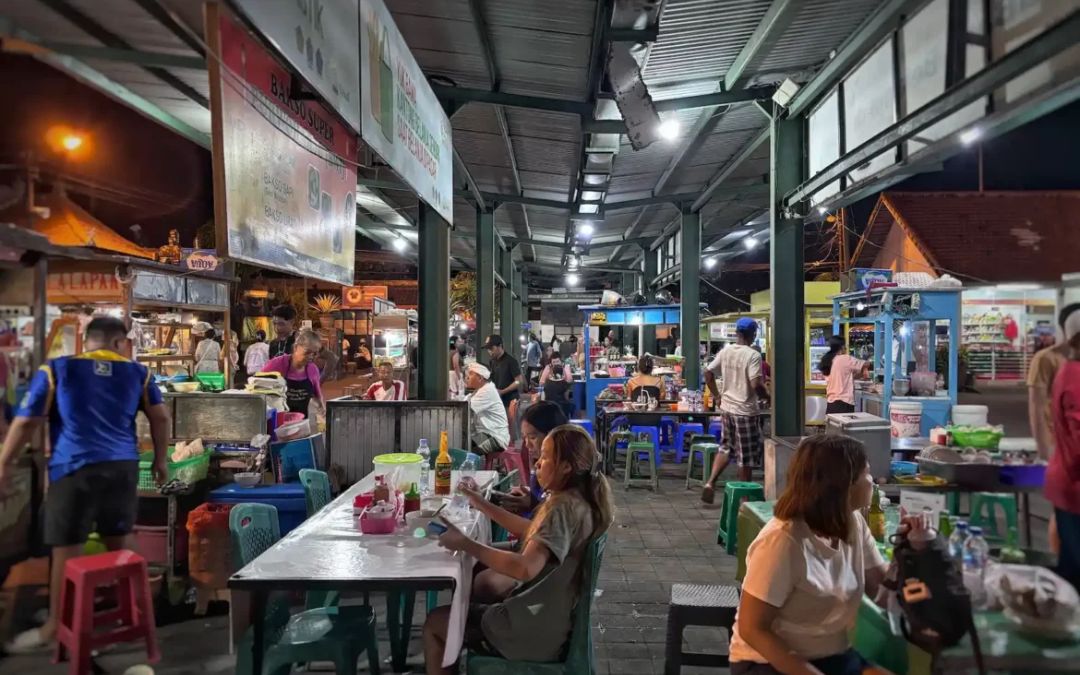
Pasar Malam glows with laughter and sizzling food.
Seminyak Beach at Dusk: Sunset as Performance
Though Seminyak leans toward luxury, it still offers moments for every traveler. As day melts into dusk, the powdery beachfront becomes a front-row seat to nature’s drama. While the sources do not confirm fire shows, spontaneous performers occasionally dazzle near the tide line—drummers, poi spinners, dancers chasing the sunset’s last light. You may find them, or they may find you. Either way, the view is the main act: wide, luminous, unforgettable.
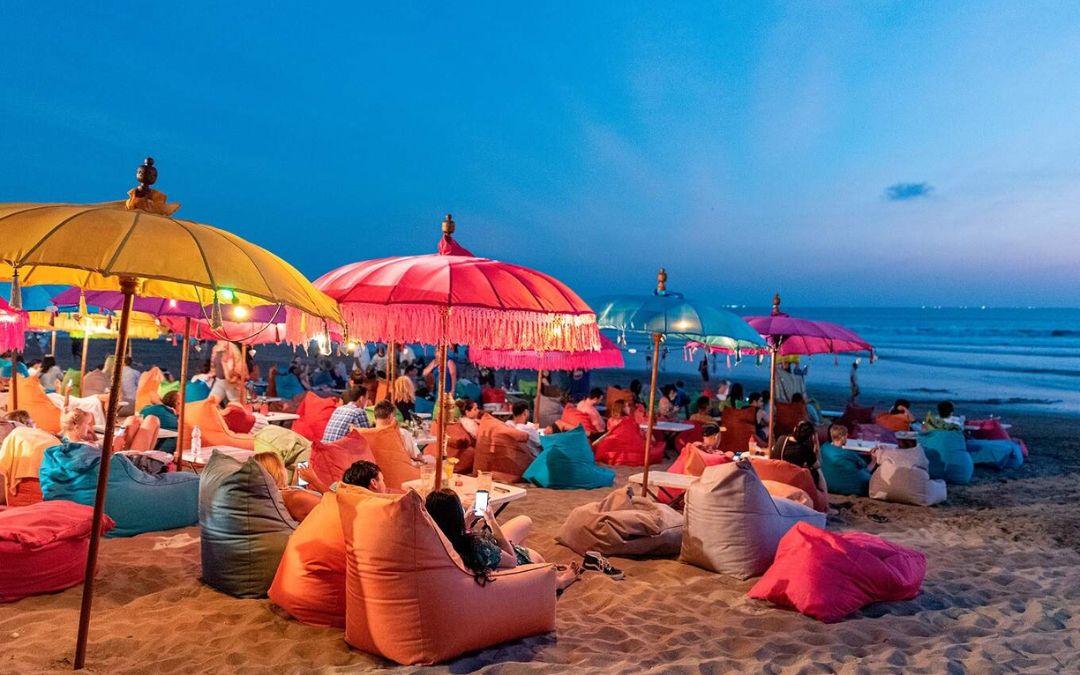
At Seminyak Beach Dusk, the sunset steals the show.
Here are a few notes for capturing Bali through your lens:
- Markets aren’t only for transaction—they are for translation. Between haggles and hellos, cameras emerge.
- At the Ubud Art Market, walk past the temple’s edge under the narrow archway and discover a rawer world of fruit, vegetables, and spice—rarely seen by tour groups.
- On the eve of Nyepi, ogoh-ogoh monsters parade with chaos and color—an unforgettable moment for the lens and the heart.
Night & Social Activities: Free Evenings that Illuminate the Island’s Soul
As the sun sets and the skies glow with deepening color, Bali transforms. Its energy shifts—not into silence, but into community, connection, and candlelit rhythm. You don’t need a thick wallet to participate.
Uluwatu Cliffs at Sunset: Spectacle Without the Ticket
Perched high above the ocean’s edge, Uluwatu delivers drama—no script, no curtain call. While the temple’s famed Kecak dance charges admission, the cliffs beyond its walls remain accessible, unguarded, and magnificent.
The view alone feels cinematic: waves smashing against volcanic stone, skies melting into shades of tangerine and violet. Come just before twilight. Stand still. Watch the monkeys dart between trees and cliff faces, as though they, too, are pulled by the spectacle. It’s not a performance—it’s a prayer in color.
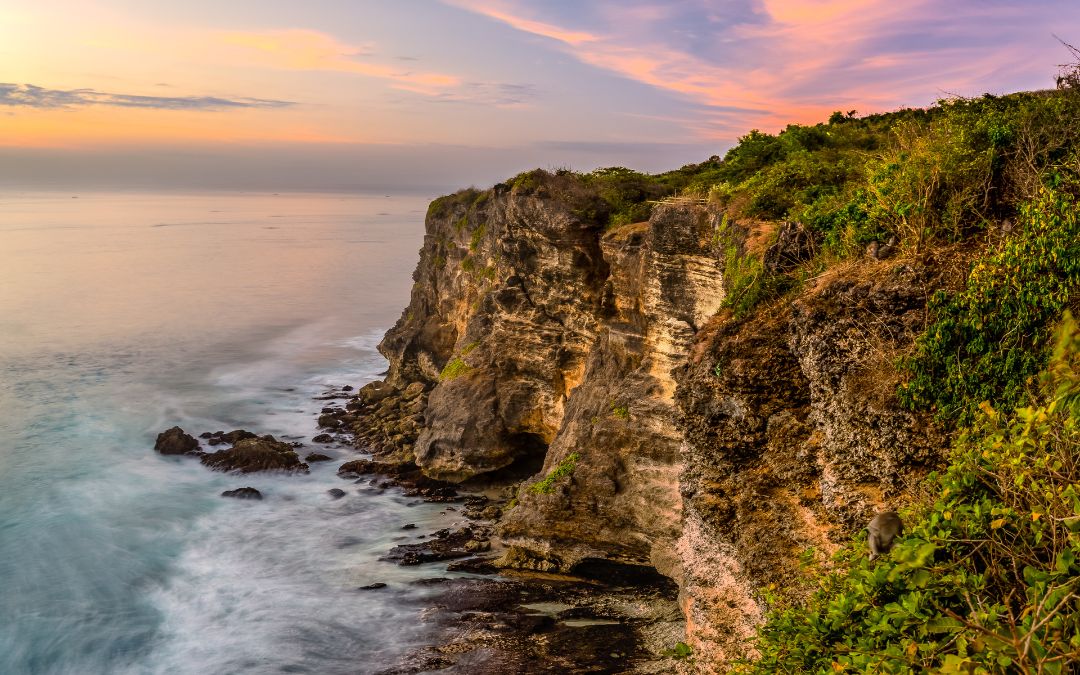
Uluwatu Cliffs blaze orange as the sun disappears.
Beach Gatherings in Canggu & Seminyak
In Canggu, life spills onto the sand. Steps near La Brisa Beach Club offer a front-row seat to the island’s famed west-facing sunsets. As the horizon burns orange, travelers gather—barefoot, relaxed, quietly unified. The music from nearby beach bars softens into the soundscape.
Just a few meters away, Sand Bar nightclub pulses into the night, though no cover charge applies to those lingering near the tide. These beach communities host spontaneous celebrations—fireside chats, guitar circles, silent dancing under stars. They’re rarely advertised, yet often remembered.
Seminyak’s sands, meanwhile, cradle a slightly different mood. Stylish yet inclusive, its beach clubs and bars open their glow to all. While venues like Ku De Ta and Potato Head radiate luxury, the beachline itself remains open, offering gentle waves and golden silhouettes without expectation or entry fee.
Free Music & Community Events
In Ubud, the night hums gently—less about excess, more about expression. Wander past cafés and bamboo pavilions, and you’ll hear open mics, acoustic sets, and spoken word sessions. These events—often donation-based or free—nourish both performers and listeners. Places like Usada Bali host holistic gatherings, including food tastings, cultural lectures, and healing sound baths, all curated for community growth rather than financial gain.
At Pura Taman Saraswati, nighttime dance performances sometimes fill the air with the hypnotic rhythms of gamelan and footfalls. Entrance to the temple remains free, and inquiries with locals may lead you to these luminous moments.
Elsewhere, the Discovery Mall in Kuta stages cultural showcases—Balinese dance, fire spinning, storytelling—all open to the public. And each Sunday, La Brisa’s Farmers Market invites families, artisans, and dreamers to mingle freely beneath canopies of twinkle lights and tropical trees.
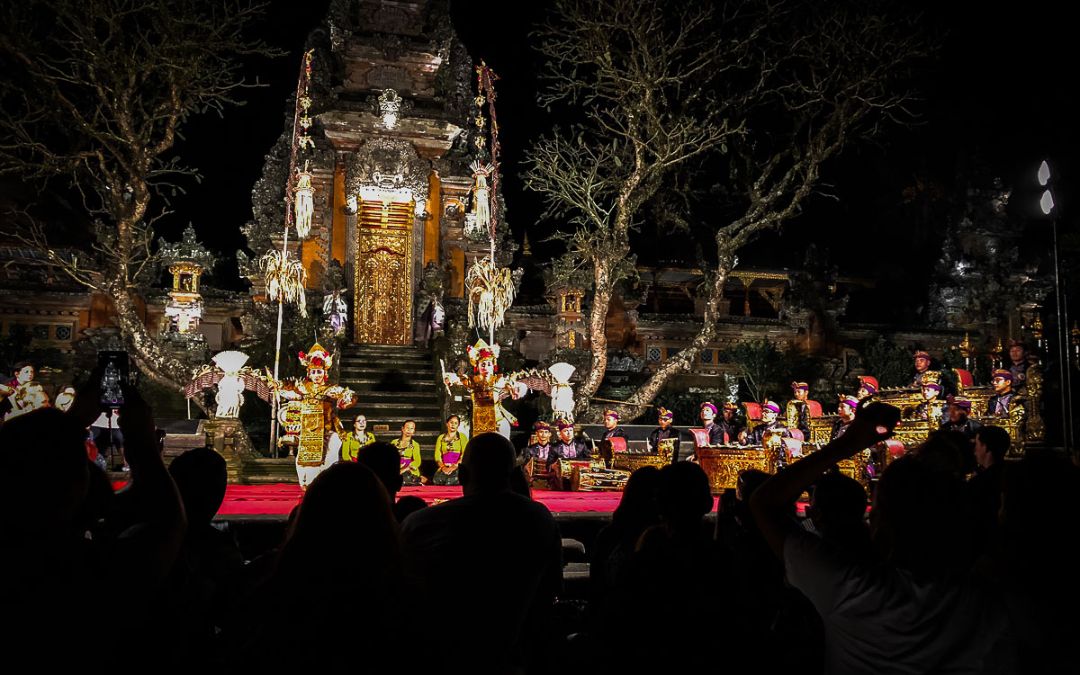
Free music nights fill the air with Bali’s rhythm.
Tips when joining night activities in Bali:
- In Bali, foreigners are often welcomed into family ceremonies, festivals, even cremations—with no price, only respect required.
- Beneath the stars or beside a fire, connections form. These aren’t activities—they’re shared human experiences wrapped in moonlight.
>> You might want to read: The Complete Guide to Dos and Don’ts in Bali for First-Time Travelers
Family-Friendly Fun: The Best Free Things to Do in Bali with Kids
Bali welcomes families with open arms and sun-warmed sands. For parents seeking meaningful moments and children yearning for discovery, the island offers countless ways to connect—without depleting the travel budget. Among the many free things to do in Bali, activities that bring generations together feel especially valuable.
Sanur Beach: Safe Shores and Sunrise Magic
With its sheltered shoreline and gentle tides, Sanur Beach has long held a reputation as Bali’s most family-friendly stretch of sand. Situated on the island’s eastern coast, Sanur’s calm lagoon creates an ideal environment for little feet to splash and swim. Even jet skiing—available here without a mandatory instructor—implies a level of water stability not common across Bali’s more dramatic beaches.
Families can stroll the paved beachfront promenade, stopping to admire kites, collect seashells, or simply enjoy the rhythmic pulse of the sea. In the evenings, the nearby Sindhu Night Market awakens with color and scent, offering budget-friendly bites and a relaxed ambiance, ideal for introducing children to Balinese flavors without overwhelming crowds.
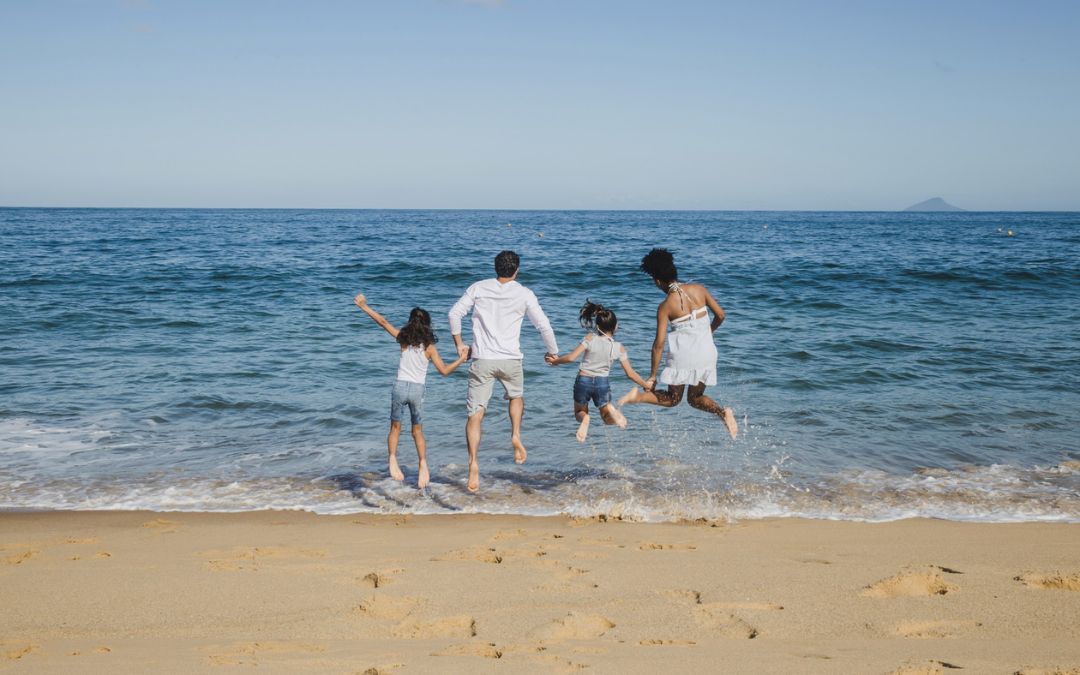
Sanur Beach offers calm waves and magical sunrise views.
Public Spaces & Parks in Ubud and Denpasar
Inland, Ubud provides a slower rhythm, one perfect for children with wide eyes and curious minds. Although specific playgrounds aren’t detailed in the sources, Ubud’s Campuhan Ridgewalk and Pura Taman Saraswati offer safe, open spaces to explore. These places let families move, wander, and marvel—whether it’s spotting dragonflies near rice paddies or admiring temple carvings under a canopy of frangipani trees.
Denpasar, the island’s capital, buzzes with local energy. While urban and often overlooked by tourists, it features gathering spots, leafy areas, and the Living World Denpasar mall, which offers air-conditioned breaks during the afternoon heat. For families needing a brief reprieve, these areas can be sanctuaries.
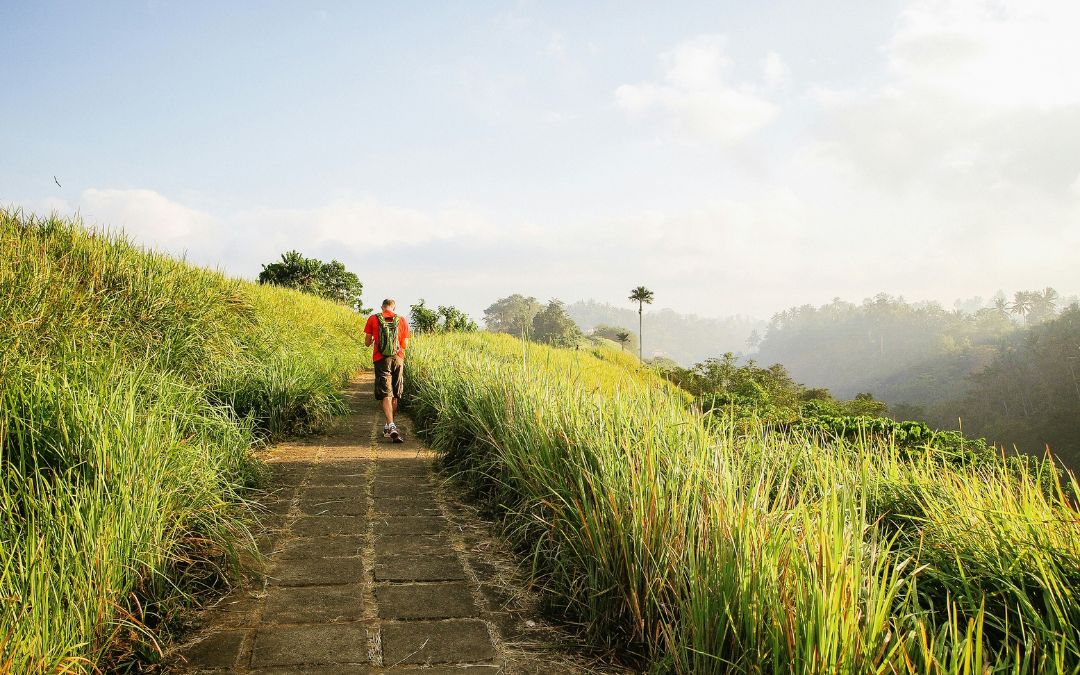
Families play freely in Ubud’s lush parks and Denpasar squares.
Optional Paid Parks (If the Budget Allows)
For travelers open to adding one or two indulgent days into their itinerary, Bali’s family attractions deliver high entertainment value:
- Waterbom Bali in Kuta, the island’s largest water park, features towering slides, water playgrounds, a lazy river, and shaded picnic spots. Its thoughtful design accommodates every age group, making it a favorite among both children and adults.
- Trans Studio Bali, an indoor theme park near Seminyak, elevates amusement to an art form. With immersive rides, a full-scale Ferris wheel, and colorful spectacles, it turns a day into a family epic. Though tickets are required, the park provides full-day value in exchange.

Waterbom Bali thrills visitors in Kuta with world-class slides and fun.
Parental tips to stay smart:
- Bali’s tropical climate demands preparation. Pack lightweight snacks—banana fritters, rice crackers, or fresh fruit from local markets—so energy stays high without straining the budget.
- Sunscreen is non-negotiable, especially during midday excursions. Water should be refilled often, and reusable bottles are both economical and environmentally responsible.
- Durable walking shoes are essential, particularly for trails like Campuhan or uneven coastal paths.
Morning and late afternoon remain the most comfortable hours for exploration. This simple rhythm—rise early, rest midday, wander again as the day cools—matches Bali’s own natural pulse and keeps the family refreshed.
>> See Tour: Adventure Bali Family Tour
Embrace Bali’s Beauty Without Breaking the Bank
Bali proves that unforgettable memories don’t require lavish spending. From serene temples and golden beaches to night markets and cliffside sunsets, the island offers a wealth of free things to do in Bali for families, couples, and culture lovers alike. These enriching moments—rooted in nature, tradition, and local warmth—highlight Bali’s true spirit without straining your wallet.
Ready to explore Bali beyond the tourist trail? Let Asia Pioneer Travel design a personalized itinerary filled with cultural charm, natural beauty, and meaningful free experiences—so you can enjoy more, spend less, and travel deeper. Get in touch today!

